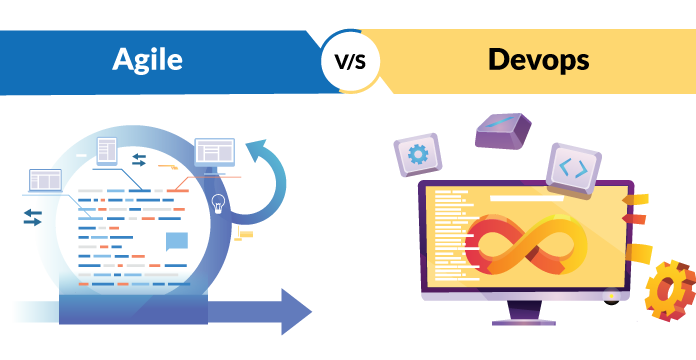
Whenever we think about Software Delivery Life Cycle (SDLC), we often think about the most common areas in which the content is produced. The first one is: when the software is created (development). And, the second, when the software is handed over to the client and feedback is collected.
Early on, software development didn’t fit under a unique management umbrella. Slowly, software development could be defined by the period an application took to design or build.
Back then, it often took long periods to design, test, and deploy software because there were no marks and balances during the development method. The results were poor software quality with errors and bugs and unmet timelines. The focus was on extended, drawn-out plans for software projects.
In this article, we will go over the key distinctions between traditional IT and Agile, and Traditional IT versus DevOps to explain why DevOps has increased popularity over the past few years.
DevOps vs Agile
Despite their connections, DevOps and agile are not the same, and some claim that DevOps is better than agile. To reduce the complexity, it’s essential to get down to the nuts and bolts.
Similarities
- Both are software development methodologies; there is no arguing this.
- Agile has been about for over 20 years, and DevOps came into the picture reasonably recently.
- Both of them focus on fast software development, and their principles are based on how fast software can be produced without causing damage to the customer or operations.
Differences
The difference between the two is what appears after development.
- Software development, measurement, and deployment happen in both DevOps and agile. However, real agile tends to stay after these three steps. In contrast, DevOps involves operations, which occur frequently. Therefore, monitoring and software development are also constant.
- In agile, separate people are accountable for developing, testing, and deploying the software. In DevOps, engineering professionals are liable for everything; development of services, operations development, etc.
- DevOps is also connected with cost-cutting, and agile is more compatible with lean and diminishing waste, and concepts like agile project accounting and minimum viable product (MVP) are relevant.
- Agile focuses on and embodies empiricism (adaptation, transparency, and inspection) instead of predictive measures.
Key Differences
Agile
- Feedback from client
- Smaller release series
- Focus on pace
- Not the best for marketing
DevOps
- Feedback from individual
- Smaller release cycles, fast feedback
- Focus on speed and automation
- Best for business
DevOps vs Traditional IT
Batch Sizes: Go from Big to Micro
Traditional IT has a preference for going tremendous and for a good reason.
Firstly, most developing shops built out of the waterfall method, which by its original quality, takes a lot of experience. Then, since releases are costly and disruptive, operations allow developers only a few windows a year to free software. And third, it’s naturally not suggestive – doing big is how you get served. As a result, community organizations maximize richness, by creating great designs that require a part of code, bundled into a release, and packed into production.
A DevOps organization needs a different point of view to understand that small is enough. They know that large batch sizes are naturally involved, risky (since there are so many moving parts), and hard to adjust. Small groups sizes, on the other hand, are simple, easy to learn and test rigorously, and less risky. If anything goes wrong, the impact is insignificant, and it is much easier and faster to fix. In other words, by going, small organizations can perform more frequent releases and convert more responsive to the client.
Scheduling: Centralize to Decentralize & Continuous
Dynamic programming is at the centre of a Traditional IT organization. Since supplies are combined, projects are usually clamoring for entrance to SMEs and support. To get around this, enterprises have spent time in complex scheduling planning systems. And while these methods are quite sensitive, they need to catch up to full time to manage, and in some instances become the existing bottleneck that they are trying to ease.
In DevOps, business schedules are pushed to the local cell level. The order of smaller batch sizes, dedicated teams, and automated processes make scheduling more comfortable to operate.
- Forecasting is restricted to the very near future (2–3 weeks) where the companies have more insights.
- There is no struggle for people’s time since it is a dedicated team.
- There is no waiting for support since it has already been set and automatically provisioned.
- It eliminates time-consuming loopbacks to management for increases and choices.
Information: Focus is on Dissemination vs Actionable
Both kinds of organizations create and share a ton of data. The distinction lies in how the companies use data. In Traditional IT, information is organized by professionals (e.g. operations team), bundled together with other data into a comprehensive report, goes through management support, is then distributed with other directors, who then give it out to their specialist. In most states, the story goes unread, just because there is too much data, no time enough, and not the correct data.
Within a DevOps organization, it’s the unit cell that collects and organizes the data. Since the data is to be applied locally, they only collect the data that the organization believes essential. And because the information is prepared within the team, it reduces the time delay of creating lengthy statements, manager approvals, and file time (sitting in someone’s email box). As a result, the team is suddenly able to read and respond to the data – rising in faster feedback time.
Culture: Does Not Fail vs Fail Early
Traditional IT is a risk-averse organization. A CIO’s priority is not to harm the business. It is the reason why IT invests in so much red tape, processes, approvals etc. All centered on anticipating failure. And yet despite all these expenses, IT has a disastrous track record – 30% of new projects are delivered late, 50% of all further increases are pushed back due to quality issues, and infrastructure issues cause 40 % of the delay.
A DevOps organization is risk-averse too, but they also realize that failure is determined. So instead of working to reduce failure, they favour deciding when and how they transmit. They prefer to fail small, fail early, and improve fast. And they have built their building and process around it. Again the building blocks we have committed to in this article – from test-driven development, daily combination, done mean deployable, small batch sizes, cell construction, automation etc. all strengthen this mindset.
Conclusion
DevOps, Agile, and Traditional IT, are three distinct methods of managing technology-driven projects. Each has its unique benefits and drawbacks, and the choice of which one to use should depend on the needs of a particular organization or project. DevOps is the most modern approach for organizations that need to move quickly and make frequent changes to their systems. Agile is suited for larger projects with multiple stakeholders, while Traditional IT is best for larger projects with fewer stakeholders. Ultimately, it is important to understand the strengths and weaknesses of each approach and choose the one that best fits the project’s needs.
Ultimately, the best approach will depend on an organization’s specific needs and goals. As a result, it may be necessary to blend different approaches or adopt a hybrid approach to achieve the desired results.
Earning the best DevOps certification can assist you in developing expertise, gaining recognition, and advancing your career. Numerous DevOps certifications are available on the market, and the better one for you will depend on your industry, current market trends, and experience level. We at Invensis Learning provide high-class training where our instructors are well-experienced in the industry. We offer many certifications in DevOps, including:
- DevOps Foundation Certification
- DevOps Professional Certification
- DevOps Master Certification














